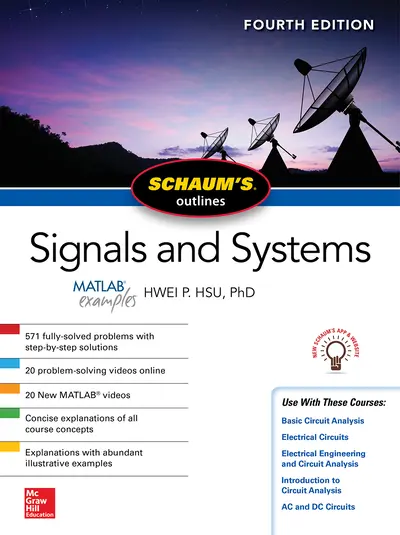My Account Details

ISBN10: 1260454258 | ISBN13: 9781260454253

Step 1 . Download Adobe Digital Editions to your PC or Mac desktop/laptop.
Step 2. Register and authorize your Adobe ID (optional). To access your eBook on multiple devices, first create an Adobe ID at account.adobe.com. Then, open Adobe Digital Editions, go to the Help menu, and select "Authorize Computer" to link your Adobe ID.
Step 3. Open Your eBook. Use Adobe Digital Editions to open the file. If the eBook doesn’t open, contact customer service for assistance.
Tough Test Questions? Missed Lectures? Not Enough Time?
Fortunately, there’s Schaum’s.
More than 40 million students have trusted Schaum’s to help them succeed in the classroom and on exams. Schaum’s is the key to faster learning and higher grades in every subject. Each Outline presents all the essential course information in an easy-to-follow, topic-by-topic format. You also get hundreds of examples, solved problems, and practice exercises to test your skills.
Schaum’s Outline of Signals and Systems, Fourth Edition is packed hundreds of examples, solved problems, and practice exercises to test your skills. This updated guide approaches the subject in a more concise, ordered manner than most standard texts, which are often filled with extraneous material.
Schaum’s Outline of Signals and Systems, Fourth Edition features:
• 571 fully-solved problems
• 20 problem-solving videos
• Additional material on matrix theory and complex numbers
• Clear, concise explanations of all signals and systems concepts
• Content supplements the major leading textbook for signals and systems courses
• Content that is appropriate for Basic Circuit Analysis, Electrical Circuits, Electrical Engineering and Circuit Analysis, Introduction to Circuit Analysis, AC and DC Circuits courses
PLUS: Access to the revised Schaums.com website and new app, containing 20 problem-solving videos, and more.
Schaum’s reinforces the main concepts required in your course and offers hundreds of practice exercises to help you succeed. Use Schaum’s to shorten your study time—and get your best test scores!
Schaum’s Outlines—Problem solved.
Preface to The First Edition
To the Student
Contents
Chapter 1. Signals and Systems
1.1 Introduction
1.2 Signals and Classification of Signals
1.3 Basic Continuous-Time Signals
1.4 Basic Discrete-Time Signals
1.5 Systems and Classification of Systems
Solved Problems
Chapter 2. Linear Time-Invariant Systems
2.1 Introduction
2.2 Response of a Continuous-Time LTI System and the Convolution Integral
2.3 Properties of Continuous-Time LTI Systems
2.4 Eigenfunctions of Continuous-Time LTI Systems
2.5 Systems Described by Differential Equations
2.6 Response of a Discrete-Time LTI System and Convolution Sum
2.7 Properties of Discrete-Time LTI Systems
2.8 Eigenfunctions of Discrete-Time LTI Systems
2.9 Systems Described by Difference Equations
Solved Problems
Chapter 3. Laplace Transform and Continuous-Time LTI Systems
3.1 Introduction
3.2 The Laplace Transform
3.3 Laplace Transforms of Some Common Signals
3.4 Properties of the Laplace Transform
3.5 The Inverse Laplace Transform
3.6 The System Function
3.7 The Unilateral Laplace Transform
Solved Problems
Chapter 4. The z-Transform and Discrete-Time LTI Systems
4.1 Introduction
4.2 The z-Transform
4.3 z-Transforms of Some Common Sequences
4.4 Properties of the z-Transform
4.5 The Inverse z-Transform
4.6 The System Function of Discrete-Time LTI Systems
4.7 The Unilateral z-Transform
Solved Problems
Chapter 5. Fourier Analysis of Continuous-Time Signals and Systems
5.1 Introduction
5.2 Fourier Series Representation of Periodic Signals
5.3 The Fourier Transform
5.4 Properties of the Continuous-Time Fourier Transform
5.5 The Frequency Response of Continuous-Time LTI Systems
5.6 Filtering
5.7 Bandwidth
Solved Problems
Chapter 6. Fourier Analysis of Discrete-Time Signals and Systems
6.1 Introduction
6.2 Discrete Fourier Series
6.3 The Fourier Transform
6.4 Properties of the Fourier Transform
6.5 The Frequency Response of Discrete-Time LTI Systems
6.6 System Response to Sampled Continuous-Time Sinusoids
6.7 Simulation
6.8 The Discrete Fourier Transform
Solved Problems
Chapter 7. State Space Analysis
7.1 Introduction
7.2 The Concept of State
7.3 State Space Representation of Discrete-Time LTI Systems
7.4 State Space Representation of Continuous-Time LTI Systems
7.5 Solutions of State Equations for Discrete-Time LTI Systems
7.6 Solutions of State Equations for Continuous-Time LTI Systems
Solved Problems
Chapter 8. Random Signals
8.1 Introduction
8.2 Random Processes
8.3 Statistics of Random Processes
8.4 Gaussian Random Process
Solved Problems
Chapter 9. Power Spectral Density and Random Signals in Linear System
9.1 Introduction
9.2 Correlations and Power Spectral Densities
9.3 White Noise
9.4 Response of Linear System to Random Input
Solved Problems
Appendix A. Review of Matrix Theory
A.1 Matrix Notation and Operations
A.2 Transpose and Inverse
A.3 Linear Independence and Rank
A.4 Determinants
A.5 Eigenvalues and Eigenvectors
A.6 Diagonalization and Similarity Transformation
A.7 Functions of a Matrix
A.8 Differentiation and Integration of Matrices
Appendix B. Review of Probability
B.1 Probability
B.2 Random Variables
B.3 Two-Dimensional Random Variables
B.4 Functions of Random Variables
B.5 Statistical Averages
Appendix C. Properties of Linear Time-Invariant Systems and Various Transforms
C.1 Continuous-Time LTI Systems
C.2 The Laplace Transform
C.3 The Fourier Transform
C.4 Discrete-Time
Need support? We're here to help - Get real-world support and resources every step of the way.